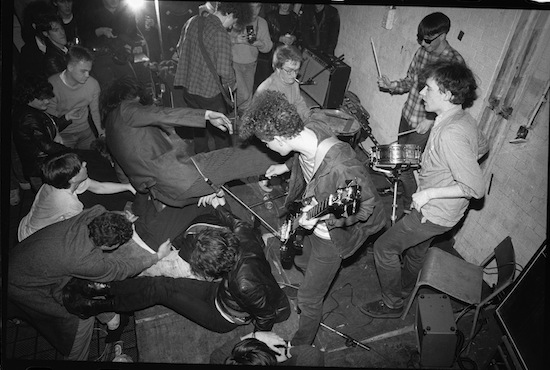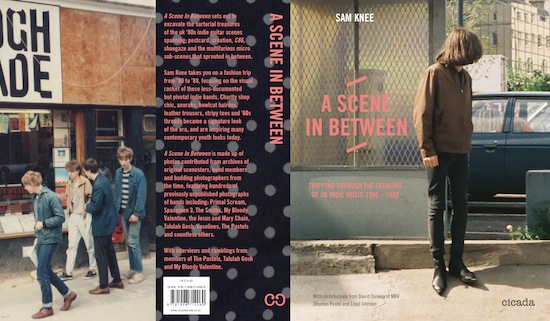If the term indie has become largely redundant since the erasure of its link to record company ownership, let alone any real sense of outsiderism, it was not ever thus. A new book by Sam Knee comprising never-seen-before photographs alongside well-selected interviews with indie greats Stephen Pastel, Amelia Fletcher, My Bloody Valentine’s David Conway plus Lloyd Johnson (Kensington Market’s most famous purveyor of indie gear), charts the UK indie movement’s fashions during its 1980s heyday.
The photographs have been lovingly compiled, gleaned from the bands and their fans, the scenes and their zines. They show the breadth of the nascent indie scene emerged out of musical genres and style tribes, from post-punks and mod revivalists, to goths and 60s garage and psychedelia fans. From the floppy fringes of Orange Juice, goofing around in 1980, to the exuberance and sheer joy of early Jesus and Mary Chain shows – a grinning Bobby Gillespie banging his solitary drum as fans and bandmates merge into a sweaty heap at the Ambulance Station, Old Kent Road, London in 1984 – via the influential lo-fi style and sound of Marine Girls, all of early indie life is here.
Like much of the scene’s music, 1980s indie fashion was a built on a bedrock of classic elements, harking back to a mythical 1950s and 60s golden age, while incorporating more clearly signified subversive elements. So it is that A Scene In Between documents the v-neck sweaters, duffle coats, floral dresses, cardigans and sensible shoes alongside the leather trousers (an unlikely element of indie fashion most memorably worn by some early Creation bands) and full face-covering bowl haircuts of “Welsh indie unknowns Flesh”. There is a similar homology in the way the cheap production, occasionally shambolic playing, and easily mimicked sound is visually represented by the ubiquitous charity shop chic.
Coming in the wake of more aggressive and instantly identifiable style tribes, indie can be overlooked in subcultural histories that skip from mod and punk to grunge and the rave scene. Yet, in the hinterland between these noisy neighbours came an underground musical movement and style tribe every bit as distinctive, if not as heralded, as either of its bookends. The “scene in between” that emerged looked, in many instances, to retreat from view. The names of bands featured in the book – The Pastels, Dolly Mixture, the Shop Assistants, the Flatmates, Felt, the Pooh Sticks, Orange Juice, the Dentists, the Sea Urchins, The Smiths – are explicitly, intentionally ordinary, unshowy, non-confrontational. This is not to say that the movement lacked political zeal or importance – withdrawing in disgust is not the same thing as apathy, as per Richard Linklater’s indie film Slacker. Simon Reynolds, in his ‘Against Health and Efficiency’ essay on indie, describes the movement as “the most appropriate gesture of defiance to the times,” as the indie community refused to conform to the dominant politics of the era.

Having opened with Orange Juice, Josef K and the Pastels, the book closes with The Boy Hairdressers, The Vaselines and BMX Bandits – cementing Scotland’s importance on the indie scene. When Stephen Pastel, who is acclaimed as being at “the vanguard of 60s unisex anorak trend”, talks of pairing “unfashionable Marks and Spencer’s v-neck sweaters, Clarks shoes, brown cords. If it was raining, an anorak was ok, and in winter, a dufflecoat” he highlights the Scottish weather as a major influence on the outerwear that became a year-round look for many (and remains an indie signifier to this day). Pastel also points out a popular argument against the definition of indie. “It’s ironic, I always hated the word ‘indie’ and if I’m truthful, I hated a lot of the music that came to be called indie. But independent music, in its originality and oddness offered me… my only possibility in terms of what I wanted to do, which was make music with like-minded people.”
Whether the indie scene, as depicted here, has been unfairly overlooked remains moot. But this brilliantly curated pictoral history – including postcards from Morrissey to a loyal fan alongside early shots of the Smiths, on and off stage – unpicks the scene’s influence and influences, showcases terrific photographs of bands both celebrated and largely forgotten, and highlights the stylistic commonalities within a musically varied subculture.
Sam Knee will be launching A Scene In Between at Mono in Glasgow on October 7th


